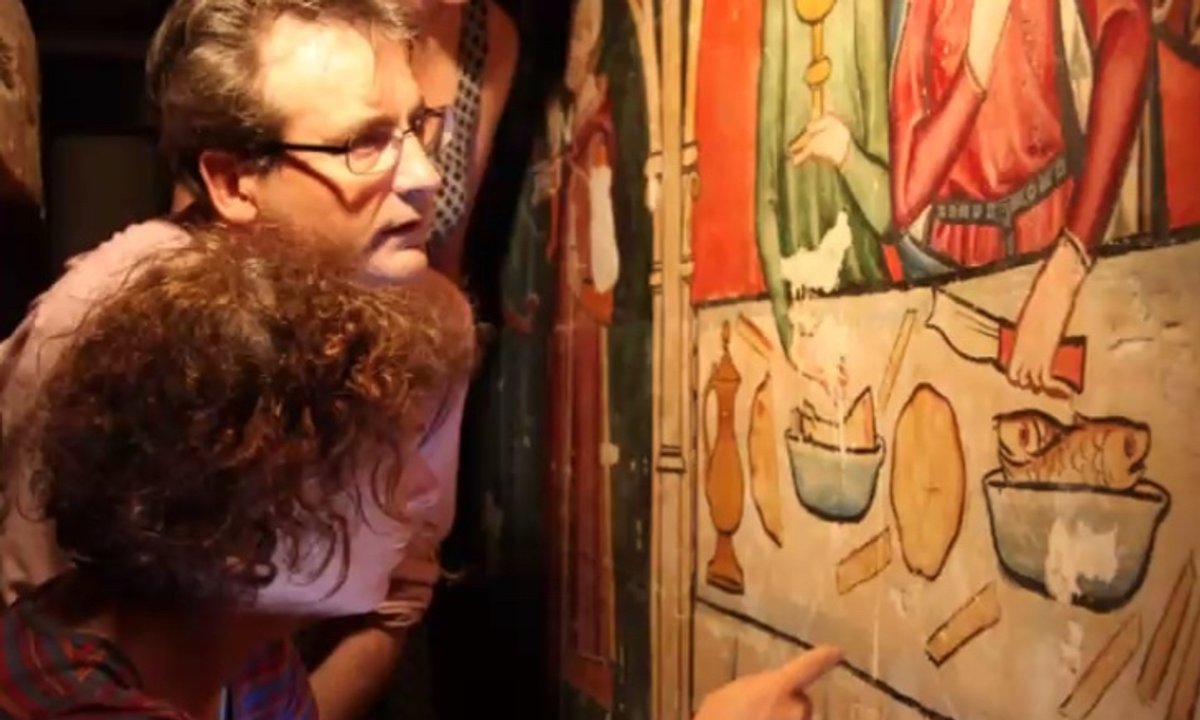Medieval wall paintings considered the finest of their type surviving from late 13th-century France, with close style links to the court of Henry III, have been revealed in all their multi-coloured splendour for the first time in more than 500 years. The walls are still, however, concealed behind panelling in the cathedral of Angers in western France.
A team of UK-based art historians and conservators has worked for a decade on creating the first full-colour image of the paintings of the life and miracles of Saint Maurille, a fifth-century bishop of Angers whose relics were once held in a silver shrine in the cathedral. The image was created by digitally stitching more than 8,000 photographs of the curving walls, taken in the crawl space behind the panelling which could not be dismantled as it forms part of the choir stalls.
The team’s thousands of photographs, distorted by the problems of access and the curve of the wall, were digitally stitched into a coherent whole by Chris Titmus of the Hamilton Kerr Institute in Cambridge, a job which took him years. The project, supported by a grant from the John Fell Fund, is published in the current issue of the Bulletin of the Hamilton Kerr Institute (November 2024).
The legend of Maurille tells of how he blessed a barren woman who then gave birth but failed to intervene when the boy died. Penitent, he threw away his church keys which were providentially swallowed by a fish, and sailed to England where he worked for the king as a gardener until the fish and the keys were miraculously served at a banquet. Identity revealed, he returned to Angers to bless the boy who rose from the dead to become Saint René whose supposed relics were also in the cathedral (his story is now believed to be entirely fabricated).
The paintings emphasise the cross-Channel voyages to England. The Angers region was the original power base of the Plantagenets, who ruled England for centuries until Richard III died at the Battle of Bosworth in 1485. The team dates the paintings to around 1270, and believes they may have been commissioned by Isabella la Blanche, half sister of the English King Henry III, or her son Maurice who may have been partly raised at Henry’s court.
After a mid 15th-century fire the paintings were whitewashed over which protected them from later attacks by iconoclasts. They were boxed in by 1786, causing damage in places, but protecting them in the French Revolution. Rediscovered by chance in 1980 by a priest using the space for storage, and carefully restored by French experts, they remained concealed and recorded only in partial black and white images. The new images, which have been shared with the cathedral, reveal the complete paintings for the first time in half a millennium.
Emily Guerry, a tutor in Medieval History at St Peter’s College, Oxford, who analysed their historical context and possible donors, described them as “absolutely sensational but trying to photograph them, spending days inching along a narrow space through dust and dead pigeons, trying to get the light and the camera angle identical for every shot, was a nightmare.”
The paintings are in oil paint, not fresco, and Guerry’s colleagues Paul Binski, an emeritus professor of the history of Medieval art at Cambridge University, and Lucy Wrapson, the senior conservator at the Hamilton Kerr Institute, note similarities to oil wall paintings of around the same date at Westminster Abbey in London, demonstrating shared knowledge of new materials among groups of painters, and possibly even the same hands at work.
The Angers paintings are evidently by two groups of painters but Binski believes the best, with confident modelling of figures and rich colour, are the most outstanding surviving from the period. He also notes the striking resemblance between the image of the handsome young king in the banquet painting, and the portrait sculpture of Henry III on his magnificent later tomb in Westminster.

